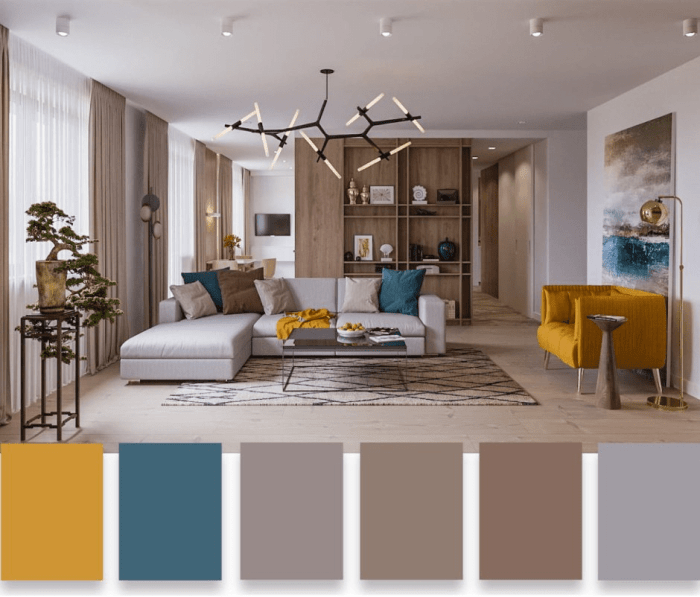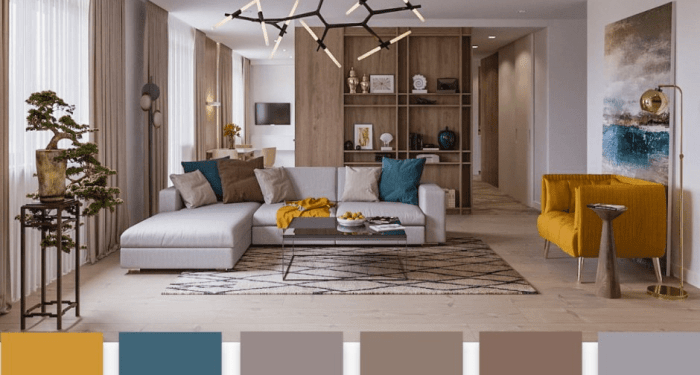Embark on a journey to discover the art of selecting the perfect interior color palette. From understanding color theory to harmonizing with the overall design, this guide will equip you with the knowledge needed to transform your space.
Understanding Color Theory
Color theory is the study of how colors interact with each other and how they can be combined to create visually appealing palettes. Different colors have unique properties and can evoke various emotions and moods when used in interior design.When choosing a color palette for your space, it's essential to understand the basics of color theory.
Here are some key points to consider:
Color Schemes
- Complementary: This scheme uses colors that are opposite each other on the color wheel, such as blue and orange or red and green. Complementary colors create a high contrast and vibrant look.
- Monochromatic: This scheme involves using variations of a single color, such as light blue, medium blue, and dark blue. Monochromatic palettes create a harmonious and calming effect.
- Analogous: This scheme uses colors that are adjacent to each other on the color wheel, such as yellow, yellow-green, and green. Analogous colors create a cohesive and soothing atmosphere.
Psychological Effects of Colors
Different colors can have a significant impact on the mood and atmosphere of a room:
- Red: Often associated with energy and passion, red can stimulate conversation and create a sense of warmth.
- Blue: Known for its calming effect, blue is ideal for promoting relaxation and tranquility in a space.
- Yellow: This cheerful color can evoke feelings of happiness and positivity, making it a great choice for spaces where you want to uplift spirits.
Overall, understanding color theory and the psychological effects of colors can help you choose the best interior color palette that suits your preferences and enhances the ambiance of your space.
Assessing the Space
When choosing a color palette for your interior, it is crucial to assess the space where the colors will be applied. Factors such as the size, lighting, and purpose of the room play a significant role in determining the most suitable color scheme.Natural light can drastically affect how colors appear in a room.
Rooms with ample natural light tend to bring out the true tones of colors, while rooms with limited natural light may make colors appear darker or duller. It is essential to consider how the natural light changes throughout the day and how it interacts with different colors.Artificial lighting also impacts color perception.
Warm lighting can enhance warm colors like reds and yellows, while cool lighting can complement cool colors like blues and greens. Understanding how the artificial lighting in the room interacts with different colors is key to creating a harmonious and balanced space.The orientation of the room can also influence color perception.
Rooms that face north receive cooler light, which may work well with cooler color palettes. Conversely, rooms that face south receive warmer light, which can complement warmer color schemes. Consider how the orientation of the room can impact the overall feel of the space.
Visual Impact of Different Colors
- Light colors such as whites and pastels can make a small room feel more spacious and airy.
- Dark colors like navy blue or charcoal gray can create a cozy and intimate atmosphere in larger rooms.
- Bold and vibrant colors can add personality and energy to a room, but may be overwhelming if used excessively.
- Neutral colors like beige, gray, or taupe provide a versatile backdrop that can easily be accented with bolder hues.
Personal Style and Preferences
When choosing an interior color palette, it's essential to consider your personal style and preferences. Your unique taste and the furniture you already own can greatly influence the color choices you make for your space. Here are some techniques to help you blend your personal style with timeless color palettes for longevity, as well as how to incorporate trendy colors without overwhelming a space.
Incorporating Personal Style with Timeless Colors
- Start by identifying your personal style preferences, whether it's modern, traditional, eclectic, or minimalist.
- Choose a neutral base color for walls and larger furniture pieces to create a timeless foundation.
- Inject pops of color through accessories like throw pillows, rugs, and artwork that reflect your personal style.
- Consider incorporating classic color combinations like navy and white, black and white, or beige and gray for a sophisticated look that can stand the test of time.
Incorporating Trendy Colors in Moderation
- Use trendy colors in small doses through accent walls, furniture pieces, or decor items that can easily be replaced or updated.
- Opt for trendy colors in accessories or smaller decor items rather than committing to a bold wall color that may quickly go out of style.
- Experiment with trendy colors in temporary ways, such as removable wallpaper or temporary wall decals, to stay on-trend without a long-term commitment.
- Blend trendy colors with timeless neutrals to create a balanced and visually appealing space that reflects your personal style while staying current.
Testing Colors

Testing colors in different lighting conditions is crucial when choosing the best interior color palette for your space. The way a color appears can vary depending on natural light, artificial light, and even the time of day. Here are some methods to help you accurately test and visualize paint samples before making a final decision.
Creating Sample Boards
Creating sample boards is a great way to see how different colors will look in your space. Simply paint small sections of your wall with the selected colors and observe them throughout the day. This will give you a better idea of how each color interacts with the lighting at different times.
Using Digital Tools
Alternatively, you can use digital tools like color visualization apps or websites to see how different color combinations will look in your room. Simply upload a photo of your space and experiment with different color options to find the perfect palette.
Observing Color Changes
Lastly, make sure to observe how the colors change throughout the day. Natural light can have a significant impact on how a color appears, so it's important to see how the colors look in the morning, afternoon, and evening before making your final decision.
This will help ensure that you choose a color palette that you'll love in all lighting conditions.
Harmonizing with the Overall Design
When choosing an interior color palette, it is essential to consider how the colors will harmonize with the overall design of the space. Selecting colors that complement the design theme or architectural style can create a cohesive and visually appealing atmosphere.
Selecting Complementary Colors
One technique for harmonizing with the overall design is to select colors that complement the existing elements in the room. For example, if the furniture and decor have warm tones, choosing a color palette with similar warm hues can create a sense of unity.
Balance Bold Colors with Neutrals
When incorporating bold colors into the color palette, it is important to balance them with neutrals to create a cohesive look. Pairing bold colors with neutral tones such as white, beige, or gray can help prevent the space from feeling overwhelming and maintain a sense of balance.
Creating Flow Between Rooms
To create a seamless flow between rooms, consider using a cohesive color palette throughout the space. This does not mean every room needs to have the exact same colors, but rather choosing colors that complement each other and create a sense of continuity.
For example, using a consistent accent color or transitioning shades of the same color can help tie the rooms together.
Closing Notes
As we conclude our exploration of choosing the best interior color palette, remember that colors have the power to influence mood and ambiance. With the right blend of hues, you can create a space that truly reflects your style and personality.
Answers to Common Questions
How important is it to consider natural light when choosing a color palette?
It is crucial to factor in natural light as it can affect how colors appear in a room throughout the day.
Can I mix different color schemes in one room?
Yes, you can mix color schemes like complementary and analogous to create visual interest, but ensure they harmonize well.
What are some timeless color palettes that blend personal style with longevity?
Neutral tones like whites, grays, and beiges are classic choices that can easily adapt to changing trends.
How can I test paint samples effectively?
Paint small sections of the wall and observe how the colors change under different lighting conditions before making a decision.





